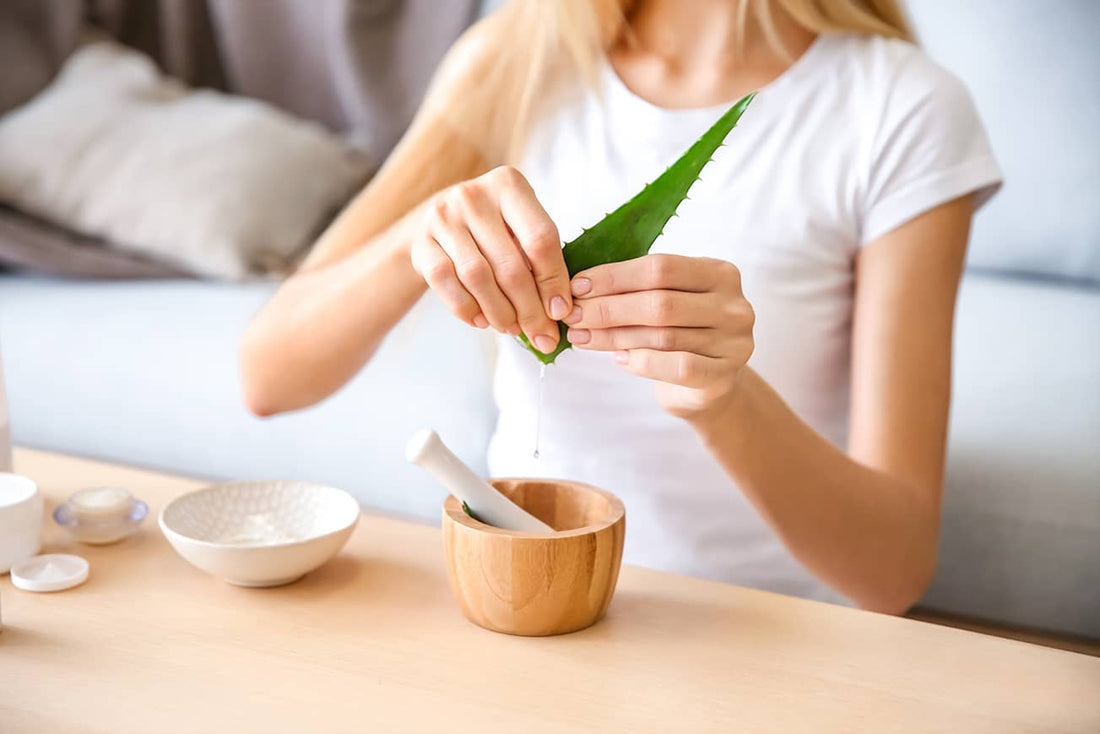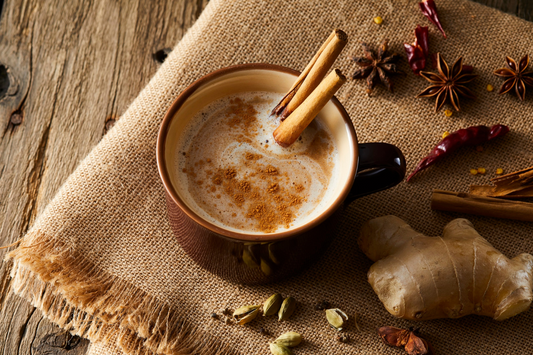Quick Summary
This in-depth guide explores the powerful skin benefits of aloe vera—a plant revered for centuries and now backed by modern science. From healing burns and fighting acne to moisturizing skin and boosting collagen production, aloe vera delivers a wide range of skincare benefits. Learn why this natural ingredient remains a trusted solution in both ancient and modern skincare, and how it works synergistically with goat milk and shea butter in our nourishing lotion formula.
There are no shortage of nutrients and product ingredients that promise to do incredible things for the skin, from clearing acne, to preventing wrinkles, to improving its overall look and feel. And then there’s aloe vera. Known for its incredible benefits for skin, aloe vera contains some of the most powerful plant compounds known to man. It can do all of the above—and even more.

History of Aloe Vera Use
Aloe vera is a succulent plant, similar to the cactus, that has long green leaves. But despite its aesthetic appeal, the true magic of the plant is locked inside those leaves; when cracked open, they reveal the gelatinous liquid that holds all of the plant’s healing power. For this reason, many people buy aloe vera plants and keep them in their homes, always at the ready at the first sign of a burn, scratch, or other minor skin issue.
Even if you’ve never treated your skin with fresh aloe vera gel directly from the plant, it’s still likely that you’ve benefited from this amazing ingredient. It can be found in countless personal care products, from after-sun gels and face masks, to body lotions and eye creams. Indeed, once you start looking for aloe vera-infused products, you’ll find them everywhere—and for good reason. The stuff has been used for thousands of years to protect and heal the skin.
According to research, the ancient Greeks believed that aloe vera was a “universal panacea” that could cure any number of ailments, while the ancient Egyptians referred to it as “the plant of immortality.” While we’re not sure if aloe vera can help you live longer, we do know that it can definitely improve the condition of your skin. Egyptian queens Cleopatra and Nefertiti seemed to agree, as they regularly used the plant’s gel in their skincare regimes. (Notably, Cleopatra also relied on the nourishing qualities of goat milk to help maintain her iconic beauty.)
Today, few aspects of modern skincare are reminiscent of ancient practices—but it’s also true that the more things change, the more they stay the same. Science and technology has improved, and, as a result, so has our ability to develop products that are better suited to our skin’s needs. Yet despite all of the latest developments, aloe vera is still one of the most beneficial ingredients you can use on your skin. Here's why.
Has antioxidant and antibacterial properties
The catalog of nutrients found in aloe vera reads like the ingredient list on a bottle of high-powered multi-vitamins. There’s vitamin B12, folic acid, and choline, as well as the antioxidant vitamins A, C and E. These antioxidants serve to neutralize the free radicals that can cause skin damage and accelerate the aging process, while also inhibiting the growth of harmful bacteria.
Meanwhile, in addition to the antioxidants found naturally in aloe vera, the plant can also stimulate the skin’s production of an antioxidant called metallothionein. Metallothionein is known for its ability to prevent “UV-induced suppression of delayed type hypersensitivity,” essentially protecting the skin from radiation damage.
Helps heal wounds
From acne prevention to anti-aging support, the skin benefits of aloe vera are both science-backed and centuries-old.
Of all its uses, aloe vera is, perhaps, best known for its ability to help heal burns on the skin. On top of providing a soothing and cooling effect, research shows that applying aloe vera can reduce the total healing time by around nine days for first- and second-degree burns. Sounds too good to be true, but it’s totally backed up by science.
Aloe vera heals burns by increasing collagen synthesis around the wound, helping the skin to naturally repair itself. It also changes the composition of collagen around the wound by increasing the amount of type III collagen produced and facilitating collagen cross link. “Due to this,” reads a 2008 article from the Indian Journal of Dermatology, “[aloe vera] accelerated wound contraction and increased the breaking strength of resulting scar tissue.

Helps fight acne
Whether you suffer from chronic acne or just the occasional breakout, you’re likely familiar with salicylic acid. Because of its proven ability to reduce inflammation and penetrate deep into the skin to unclog pores, this beta hydroxy acid is in just about every over-the-counter acne treatment, as well as some prescription medicines. But while salicylic acid is certainly effective, it can also be drying and irritating if applied excessively, particularly when it’s artificially manufactured.
The salicylic acid found in aloe vera is naturally occurring and, as a result, gentler on skin. And it doesn’t just unclog pores and fight acne, either. It’s also an effective exfoliant that can gently slough away dead skin cells, as well as the scars and hyperpigmentation that some breakouts can leave behind. The key is to be realistic about your expectations when using aloe vera for acne-related concerns.
In an interview with Baylor College of Medicine, Kim Chang of the Baylor Aesthetics Studio notes that aloe vera works best when treating superficial acne, as opposed to cystic acne that begins deep below the skin.
Slows the aging process
Chang also spoke about aloe vera’s anti-aging properties.
“One popular question is, can it help get rid of my wrinkles, and the simple answer is no,” said Chang. “A big thing to differentiate is that it doesn’t reverse your skin from aging, but helps prevent you from getting deeper wrinkles and lines.”
This wrinkle prevention can be attributed to aloe vera’s ability to stimulate collagen production, which plumps the skin and increases elasticity. In fact, one study showed that, when 30 women over the age of 45 applied aloe vera gel to their skin over a 90-day period, they saw a significant increase in collagen production, which lead to improvements in the appearance of wrinkles as well as skin elasticity.

Moisturizes skin
When you apply pure aloe vera gel to your skin, it doesn’t exactly feel like a standard body lotion or cream. But that doesn’t mean it’s not moisturizing. Aloe vera contains mucopolysaccharides, a type of sugar that helps bind moisture onto the skin so it can penetrate deep below the surface layers.
In a study on the moisturizing effects of aloe vera, 30 women were told to wear a glove that “provided gradual delivery of aloe vera gel to skin,” and the results were “uniformly positive.” The women reported less dryness via “improved skin integrity, decreased appearance of fine wrinkling, and decreased erythema.”
Back to You
If you weren’t already a huge aloe vera fan, you certainly should be now, after reading this article. If potted plants are your thing, we totally recommend buying an aloe vera plant for your home. But we also want to make your life super easy by sharing our aloe vera-infused Goat Milk Lotion with you.
Typically, when we talk about our products, we talk about what’s NOT in them—there are no alcohol, dyes, parabens, phthalates, synthetic preservatives, artificial fragrances, GMO ingredients, or any other chemical compounds that could potentially wreak havoc on your skin. But in the case of our lotions, we also need to discuss what they do have.
Whether you choose the calming Lavender, the invigorating Sweet Orange, or any of our other scents, you can trust that they are made with all-natural goat milk and shea butter. When combined with antioxidant-rich aloe vera, it produces a cream that is deeply nourishing and effective—but gentle enough to use on a newborn, or on your face.
Curious about how aloe vera can change the look and feel of your skin? Give our Goat Milk Lotion a try and see for yourself.
Frequently Asked Questions
What are the benefits of aloe vera for skin?
Aloe vera helps heal burns, fight acne, moisturize deeply, and slow visible signs of aging by stimulating collagen and providing antioxidants.
Can aloe vera help with acne?
Yes. Aloe vera contains naturally occurring salicylic acid that unclogs pores, reduces inflammation, and gently exfoliates skin without over-drying.
Does aloe vera actually reduce wrinkles?
While aloe vera doesn't reverse wrinkles, it helps prevent deeper lines by boosting collagen production and improving skin elasticity over time.
Is aloe vera moisturizing for dry skin?
Absolutely. Aloe vera is rich in mucopolysaccharides, which bind moisture to the skin and penetrate deeply to restore hydration and improve texture.
How is aloe vera used in goat milk lotion?
In our goat milk lotion, aloe vera combines with shea butter and all-natural goat milk to nourish and soothe skin with no harsh chemicals or synthetic additives.





9 comments
Hi, would Aloe Vera work for cystic acne scarring?
Thank you
Hi
Which products have aloe Vera?
I love, LOVE your products!!
I got the lavender lotion it is light not greasy and a mild scent